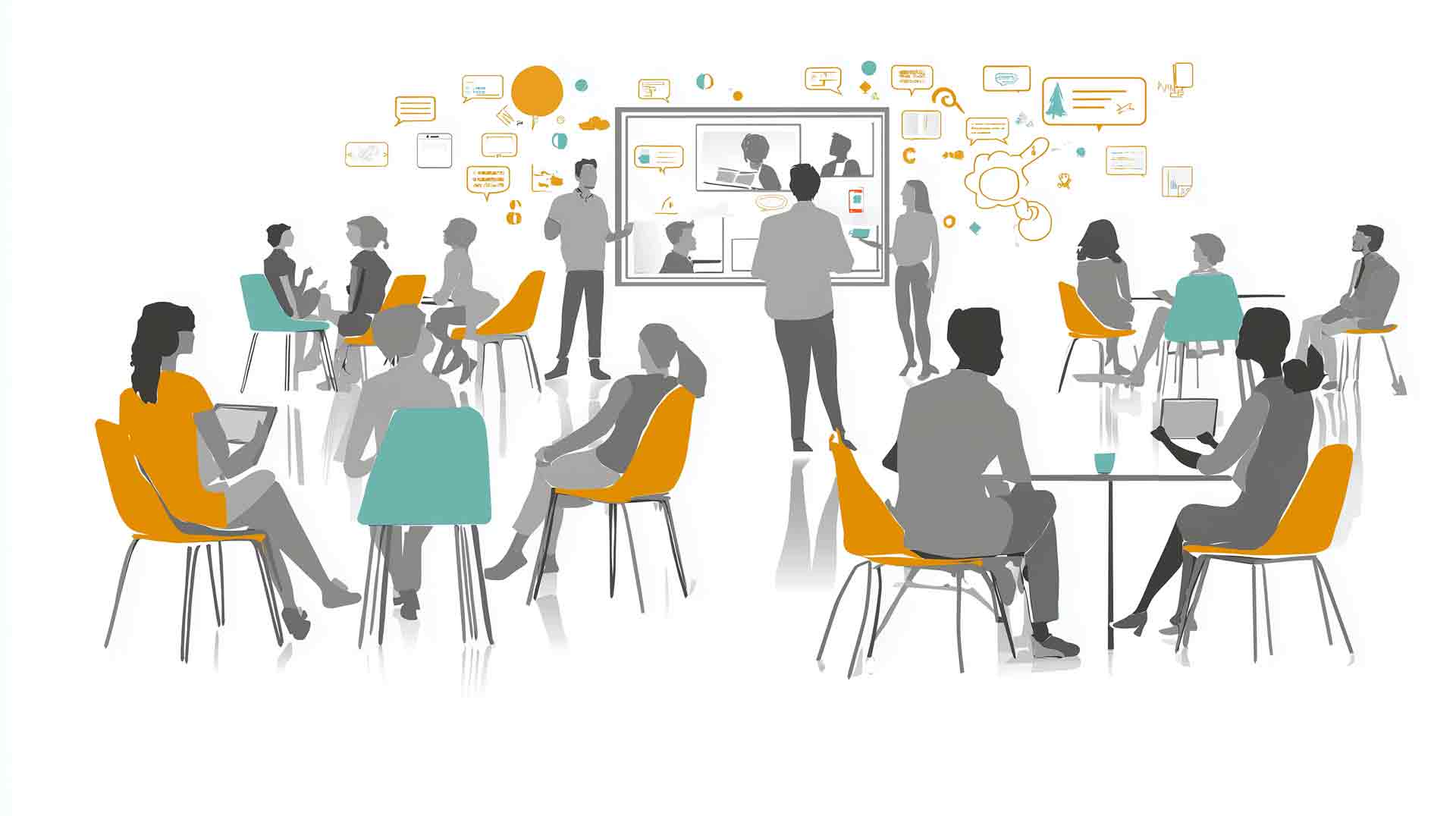4 min read
Hybrid Learning Engagement Secrets: Don’t Let Remote Learners Drift
 Karen Vieth
:
Oct 20, 2025 8:00:02 AM
Karen Vieth
:
Oct 20, 2025 8:00:02 AM

Hybrid sessions feel like the best of both worlds—until remote learners start disappearing.
They log in. They stay quiet. And slowly, they disengage.
It’s not always obvious at first. Cameras may be off by default. A few answers trickle in through chat. But behind the screen, they’re drifting because the experience wasn’t built equally for them.
In hybrid learning, engagement isn’t guaranteed. Especially for your remote participants.
So how do you keep them connected? You design for it and support it with tools they’ll use after class.
Key Takeaways
- Hybrid learning introduces new engagement risks—especially for remote participants who feel unseen or excluded.
- Microlearning keeps learners anchored—short, focused tools bridge the remote/in-person gap.
- Design for all three engagement types—emotional, intellectual, and environmental.
- Use six proven tactics to prevent drift—from assigning remote-first roles to narrating visuals.
- Apply the InQuire Engagement Framework™—to ensure equitable experiences across every delivery format.
Use Microlearning to Keep Hybrid Learners Anchored
When sessions end, learners forget. That drop-off is faster for remote participants, who often miss subtle cues and side conversations that help information stick.
Microlearning helps close that gap.
By creating small, focused assets—like job aids, checklists, and one-page tools—you give learners something to revisit later. When those assets are used during class, they tie the learning together across in-person and remote experiences.
Here’s how microlearning supports hybrid engagement:
- Emotional: Ensures everyone feels part of the same learning moment
- Intellectual: Tools reinforce problem-solving and transfer
- Environmental: Gives remote learners tangible, accessible resources
Instead of using a long slide deck, try sharing a decision map, guiding the discussion with annotations, and emailing it afterward. In-room learners might print it. Remote learners might save it to their desktop. Everyone leaves with a tool they’ll actually use. It’s one of the simplest ways to bridge the gap between in-room and remote learning environments.
Engagement Isn’t Automatic. It’s Environmental
In-person learners benefit from energy in the room: eye contact, body language, hallway conversations. Remote learners operate in a different space, often isolated and distracted.
That’s why environmental engagement—the third pillar of the InQuire Engagement Framework™—is critical.
When it’s missing, learners:
- Struggle with tools
- Feel excluded from in-room dynamics
- Stop participating
Fix it with structure:
- Set expectations early. Show learners how to interact, what to expect, and how to get support
- Assign a producer. Let them monitor chat, troubleshoot issues, and advocate for remote inclusion
Design Tip: Start sessions with a warm-up using tools like chat or annotation. Give remote learners a chance to interact right away.
Emotional Engagement Begins Before the Lesson Starts
Remote learners often feel like afterthoughts. That emotional disconnect leads to disengagement.
To fix it, build emotional engagement intentionally:
- Greet remote learners by name
- Use inclusive framing (“Everyone online, you’ll see the prompt now”)
- Acknowledge contributions from chat, voice, or polls equally
One simple adjustment can change the tone. In a hybrid leadership session, remote learners were asked to lead debriefs. They spoke first and participation increased instantly.
“Once we validated remote input early, the whole tone of the session changed.”
— InSync Facilitator, Global Finance Program

For more ideas, check out our post on "11 Ways To Increase Virtual Learner Engagement"
Intellectual Engagement Doesn’t Happen by Watching
In well-designed hybrid learning programs, facilitators ensure remote participants aren’t treated as passive observers—they’re equally seen, heard, and equipped.
When content is delivered passively, learners disengage. That’s especially true for remote participants, who have fewer visual or physical cues to follow along.
Intellectual engagement means:
- Asking open-ended questions
- Promoting real-world application
- Letting learners solve problems and compare ideas
To include everyone:
- Use shared prompts across locations
- Design breakout tasks with equal roles
- Highlight remote insights during debriefs
Balance Is the Secret to Hybrid Engagement
In a hybrid classroom, the energy can naturally lean toward in-person learners who are physically present, audible, and visible. Using the InQuire Engagement Framework™, you can ensure emotional, intellectual, and environmental engagement are interconnected. One dimension impacts the others.
Here’s what that might look like:
|
Facilitator Action |
Engagement Type |
|
Ask remote learners to annotate a shared slide |
Environmental |
|
Facilitator reflects on a comment by name |
Emotional |
|
Prompt: “What might go wrong if we skipped this step?” |
Intellectual |
When all three dimensions are supported, learners stay connected.
Six Fixes to Prevent Hybrid Learner Drift
The challenge of keeping remote participants engaged isn’t just about technology, it’s about building habits that equalize voices in the hybrid classroom. Here are six field-tested ways to keep remote learners engaged throughout your hybrid session.
- Use Microlearning to Level the Field
Design short tools like checklists or visual job aids. Use them during the session, then share them after. Everyone, regardless of location, gets a resource they can act on.
Want a deeper dive?
Register for our Virtual Classroom Microlearning Approach Workshop.
- Design Parallel Experiences
Avoid just “streaming” the classroom. If in-room groups use a flipchart, remote learners should collaborate in shared docs with the same prompt.
- Assign Remote-First Roles
Give remote learners roles like notetaker, reporter, or breakout lead. Center their experience instead of treating it as secondary.
- Narrate the Visuals
Don’t assume everyone sees the whiteboard. Describe what’s happening so remote learners stay aligned.
- Use a Producer as an Engagement Partner
Using a producer or platform support role can free up the facilitator to focus more on connection than logistics. Producer support in hybrid sessions is critical for maintaining engagement equity. Producers can track chat, manage tool use, and flag when remote voices are being missed. Treat them as a co-facilitator.
- Aim for Interaction Every 3 to 5 Minutes
Build engagement pulses into the session. Ask, “What’s one word that describes your reaction?” or “What stood out to you so far?”
Hybrid Case in Point: Inclusion Drives Results
A healthcare organization was struggling to engage remote participants in hybrid onboarding. After applying the InQuire Framework™, they made three key changes:
- Emotional: Paired remote learners with in-room peers
- Environmental: Added pre-session tech checks with producers
- Intellectual: Rewrote activities so remote learners led scenario discussions
The results? Remote participation tripled and learner satisfaction rose 19%.
Engagement Isn’t Extra. It’s Essential.
You might have 30 learners signed in. But how many are actually using what they learned?
Engagement isn’t measured by attendance. It’s measured by application.
To bridge that gap:
- Use The Virtual Engagement Scorecard to assess emotional, intellectual, and environmental signals
- Design with tools that learners will use beyond class
- Follow up with prompts like, “What’s one thing you’ll apply this week?”
Hybrid learning doesn’t end at logout. Neither should your engagement strategy.
Final Thought: Don’t Just Include Remote Learners.
Design for Them.
If your hybrid learning experience doesn’t serve remote participants equally, it doesn’t serve the full group.
When you design with intention, the hybrid learning model becomes more than a delivery method—it becomes a meaningful experience for everyone involved.
Use the InQuire Engagement Framework™ to guide your design. Create moments that connect. Use microlearning to anchor retention. Make remote learners full participants—before, during, and after every session.
Is Your Hybrid Program Leaving Remote Learners Behind?
Schedule a Strategy Call to learn how InSync helps teams deliver hybrid learning that actually works!


